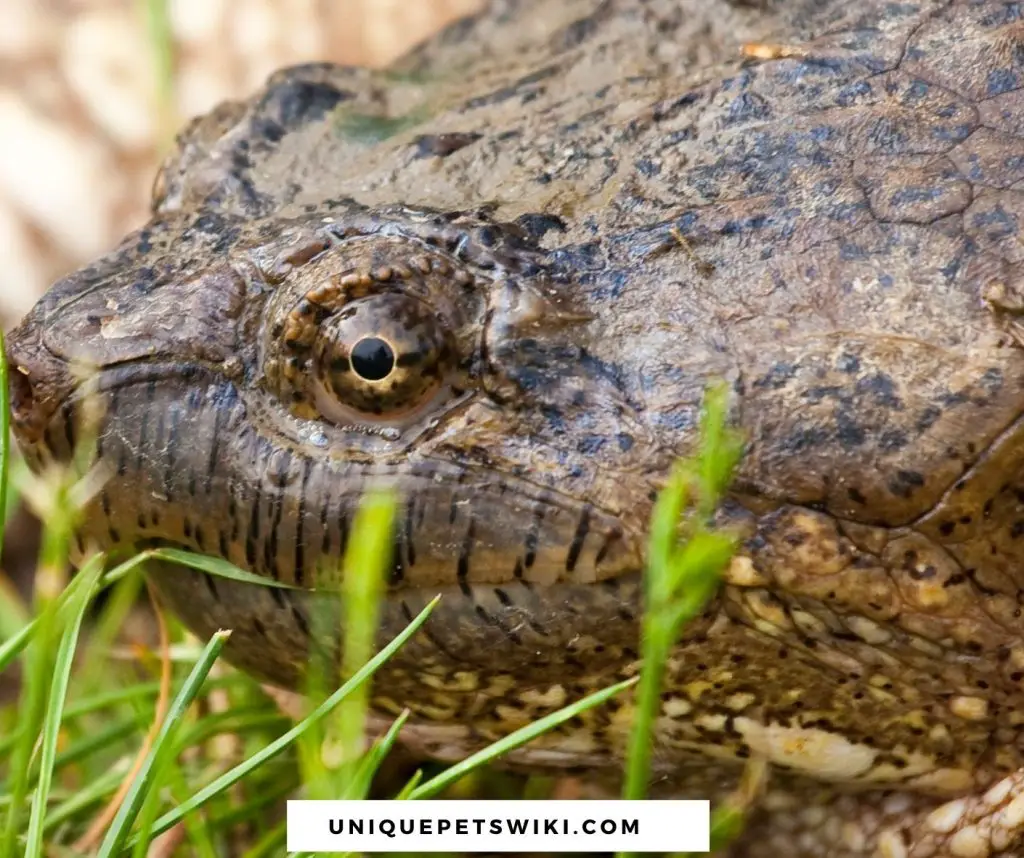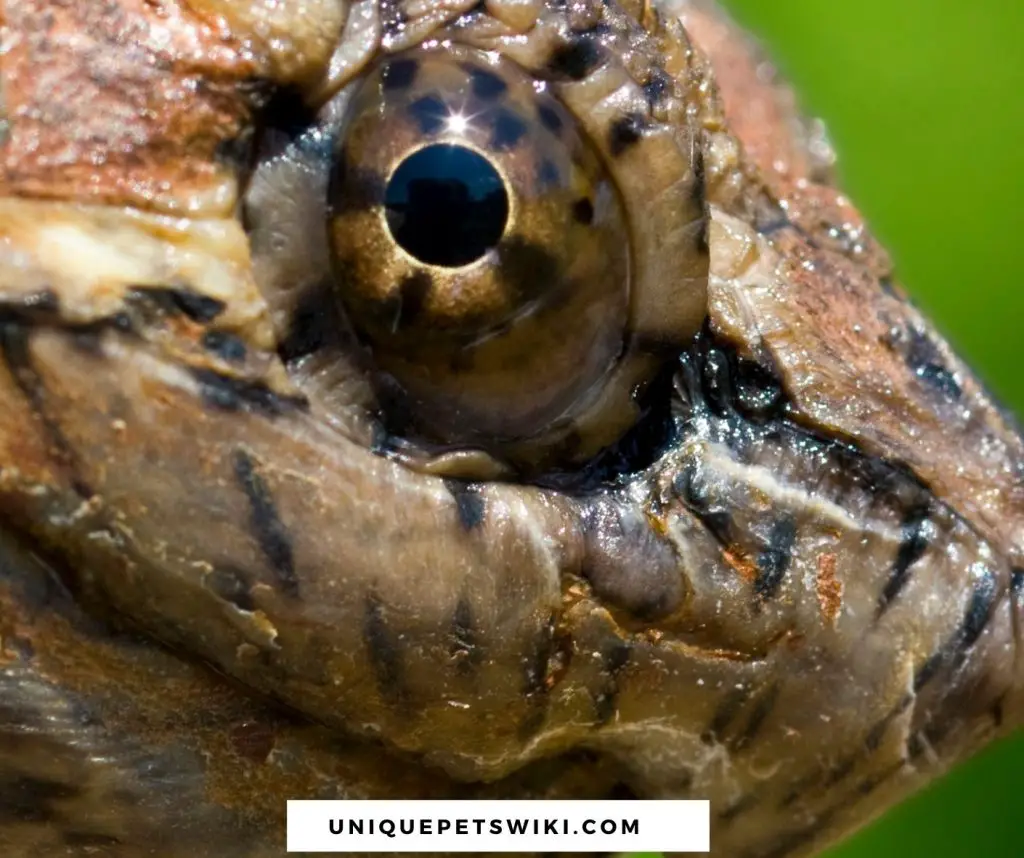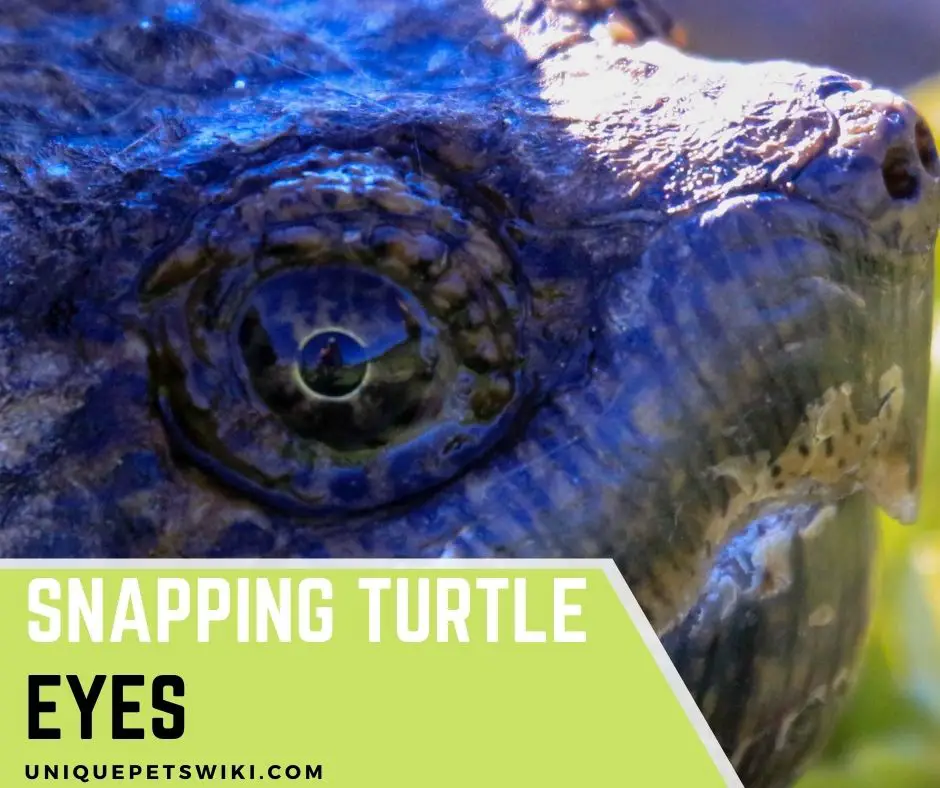What comes to your mind when you look at your pet snapping turtle’s eyes? You may even wonder if they see in the dark or can see colors.
Snapping turtles, among other species of turtles, have well-developed eyes and sight. With this, they can see both on land and in the water.
However, even with their super sharp eyes and ability to see clearly, they still can’t detect objects or see patterns with their peripheral vision (that is, they can’t see objects outside the range of their gaze or central area of focus).
This is to imply that, although snapping turtles have well-developed eyesight, the extent to which they can see cannot be compared to other species of animals such as chameleons, Gekkota (nocturnal geckos), mantis shrimps, and many others.
In this regard, this article seeks to give you some vital information on snapping turtle eyes and answer any questions you have about snapping turtle eyes. Enjoy reading!
This article has been reviewed by Dr. Gospel. Read more about our knowledge control process here.
Contents
What Color Is Snapping Turtle Eyes?
Just like humans, a snapping turtle’s eye color varies from species to species. Males tend to have different eye colors from females.
They have black pupils and yellow chicken-fat irises to easily identify snapping turtles from other species of turtles with their eyes. Their eyes also exhibit about 4, 5, or 6 patterns of black spots like starbursts or a cross that stem from the pupil all the way down the iris.
How many black spots/patterns a snapper has in its eyes depends entirely on the individual turtle. Some snappers have 4 black spots stemming from their pupil down to the iris, forming a cross shape.
On the flip side, other snappers may have 5 or more black patterns resembling a starburst.

Can Snapping Turtles See In the Dark?
Yes, snapping turtles and other species of water turtles can see in the dark. In fact, snapping turtles are more active at night than they are during the day, which makes them more nocturnal in nature than diurnal.
For this reason, if you’re keeping your pet snapper in an extremely lighted aquarium, the turtle will likely get stressed and predisposed to infections and diseases because of a weakened immune system.
Common Eye Problems of Snapping Turtles
Eye problems, like other types of diseases, are common and inevitable in pet animals, including snapping turtles. Especially with animals that are not properly taken care of.
However, it is possible to keep a pet without any health issues successfully. Of course, this can only be made possible with optimal husbandry and care.
This section will expound on common snapping turtle eyes problems, such as swollen eyes, abscesses, and many more.
Also to be discussed in this section are the causes and home remedies/treatments for these snapping turtle eye problems.
Turtle Swollen Eyes
Swollen eyes in snapping turtles don’t occur independently. Oftentimes, it is a result of ear abscesses and respiratory infections. If your turtle suffers from ear abscess or respiratory infection long enough without treatments, it’s likely to cause the eyes to swell.
Other factors that cause swollen eyes are poor diet and poor habitat. Poor habitat in terms of dirty and contaminated water. Trauma to the head can also result in a swollen eye in these reptiles.
Symptoms
When turtles are infected in the eye, it is easy to tell because they will exhibit behaviors such as eye rubbing or watery eyes to signal the keeper that something is wrong with their eyes. These symptoms include:
- Cloudy eyes. This sign can occur in only one or both eyes.
- A runny/watery eye. Initially, this sign might be difficult to detect on time. However, if you have had a habit of closely examining your turtle regularly, it’ll be easy to tell when it is in discomfort.
- Another sign that your snapper is infected in the eyes is if it constantly keeps rubbing its eyes. Rubbing the eyes is usually the first sign of irritation or injury. As a good keeper, once you notice this, you must identify and treat the underlying cause before it worsens.
- Swollen eyelids and excessive discharge from the eyes are also signs of infections in the eye.
- Loss of appetite. In the wild, snapping turtles are sight feeders. This means they hunt prey with their eyes, and they will starve to death without good sight.
Besides being unable to hunt without good sight, they are predisposed to attack by predators and can’t defend themselves.
Even in captivity, they are likely to starve if they are infected in the eye. This is because they wouldn’t be able to see the food you offer them. This is why you should treat your turtle for eye problems before it gets worse.
Causes
- The major causes of eye problems in snapping turtles and other species of turtles are poor habitat setup and poor husbandry. Dirty and contaminated water all constitute poor habitat setup.
- Snapping turtles are freshwater animals. Hence, they do not need tap water in their tank. The reason is that tap water contains chemicals, such as chlorides, that cause eye irritation.
On the flip side, even if you use treated fresh water for your snappers, without a proper water filtration system and regular water changes, the water will get dirty and become a haven for infection-causing bacteria to breed.
- Vitamin A deficiency due to poor dieting is also a major cause of eye problems in snappers and other animals. That is why knowing what foods to feed and not to feed to your snapper is essential.
- Dehydration is another possible cause of swollen eyes in turtles, especially land turtles.
Turtle Eye Infections
As earlier stated, when the aquarium isn’t properly maintained as supposed to, it creates a breeding ground for infection-causing bacteria to thrive. And one of the body parts of your snappers that bacterial infections attack is the eyes.
With this in mind, the importance of fresh, clean water with a functioning filtration system in your pet’s aquarium cannot be overstated.
Since they are aquatic, you have to ensure that the water in which they spend their entire time is free from chemicals, contamination, and bacteria.

Abscess
An ear abscess is often a cavity in the ear filled with pus that is caused by inflamed tissues or tissue destruction.
Ear abscesses can affect snappers’ eyes if they are large enough to press on the optic nerve or cause an inflammation that becomes generalized.
Once this happens to any animal species, including snappers, the effect is a swollen eye. Several factors hovering around poor husbandry are possible causes of destroyed and inflamed tissues in pet snappers.
Closed Eyes
“Closed eyes” is an eye condition that is peculiar to newborn turtles. Although this problem hasn’t been scientifically proven to be a birth defect, the problem can exacerbate if left unattended.
Always refer treatments to the veterinarian, as oftentimes, lab tests would need to be conducted before treatment.
Treatments For Snapping Turtles Eye Problems
For you to effectively treat your pet snapper of an eye problem, you first have to diagnose the underlying cause/factor. Once this is known, it will guide you on what type of treatment and medication to give.
An eye infection caused by water contamination and harmful chemicals in the water will need a complete change of water treatment.
An eye problem caused by chlorine chemicals from tap water will need the water to be dechlorinated.
If the eye problem is caused by vitamin A deficiency, then you have to supplement its diet and review the kinds of foods you have been feeding to your pet.
The same thing will apply to ear abscesses if the eye problem results from ear infections.
Whatever the cause is, you’ll need to consult your vet for proper diagnosis and treatment.
Abscesses should be treated surgically by an experienced vet. Usually, the abscess will be opened, the pus will be drained, and the affected tissue(s) will be flushed with a medicated cleansing solution.
In some cases, a culture of the abscess may be needed to determine the type of bacteria that caused the abscess. Topical medication and injectable antibiotics may also be required.
Cipro would work for eye infections caused by bacteria but might not work for others caused by irritation or viral agent. Ciprofloxacin is a broad-spectrum antibiotic. It can be used for eye infections but only after a sensitivity test is done to determine if the causative agent of that incident is sensitive to Cipro.
Preventing Eye Problems In Snapping Turtles
The best treatment for any disease you can give to your pet is to prevent the disease from occurring in the first place.
In this regard, ensure your turtle has plenty of fresh water, bedding, and accessories in its tank.
- Regularly clean out dirt from the tank, especially after every meal and when you see some poops.
- Ensure you install a sound water filtration system to keep the water clean.
- Do not use untreated tap water for your pet.
- Do a complete clean-up and water change every 3 months and avoid stress by handling.
- Also, ensure that the aquarium is appropriately humidified. Snapping turtles being aquatic animals, do not require high humidity levels. At the same time, insufficient air will cause health problems or even death.
- A proper diet of animals and plant matter should be provided. Foods rich in vitamin A should also form the bulk of their diet.
If the foods you offer them aren’t rich in vitamin A, supplement their diet. A vitamin A deficient snapper can be treated orally (powder) or injectable vitamin A (given orally).
Hypovitaminosis A (vitamin A deficiency) should only be treated under veterinary supervision as hypervitaminosis A (excess vitamin A) can occur.
Wrapping Up
Pet aquatic animals are some of the easiest pets to have and care for. They do not require handling and lots of attention.
Even with that, to successfully keep any species of aquatic animal, you have to adhere to all its husbandry DO’s and DON’Ts, and these include:
- Using fresh and clean water,
- Installing a working filtration system,
- Maintaining proper temperature all the time,
- Feeding it appropriate food all the time,
- Regularly cleaning out dirt from the water, and
- Periodically changing the water.
Without observing all these precautions, you’ll likely have regular vet trips when sickness strikes.
At this point, it’s important to mention that eye problems in snappers and other species of turtles occur due to other diseases that have attacked the animal.
For instance, a vitamin A deficient snapper will have lots of other health issues, including a gradual breakdown of epithelial tissues that makes the eyes more predisposed to infectious attack.
As discussed in this article, snapping turtles have clear black pupils and yellow irises with some black patterns stemming from the pupil down to the iris. This should make it easy for you to know when your pet is having issues with its eyes.
Once the eyes are cloudy, swollen, runny, or itchy to your snapper, all these are signs that either of the eyes is infected.
To detect on time when something is wrong with your pet snapper, cultivate the habit of regularly observing your turtle from outside the tank and keep records of its behavior and feeding habits.
